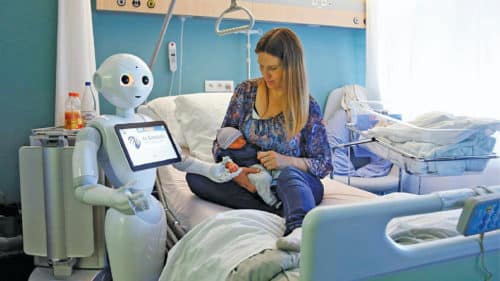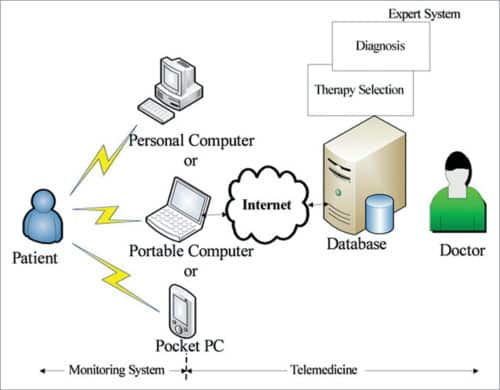This article covers the importance of AI in healthcare, examples of AI in healthcare, the Indian healthcare industry, telemedicine, digital healthcare and related information technology.
It’s not a surprising fact that medical error is the third-largest killer in the US, next to heart disease and cancer. As per some reports, medical errors claim about 400,000 lives each year in the US. The number of deaths in India is much higher. A recent study by Harvard University showed that nearly five million deaths occur in India annually due to medical errors.
The most common errors are related to diagnosis, prescription and inappropriate use of medicines. Millions of patients are harmed each year due to unsafe healthcare worldwide, resulting in 2.6 million deaths annually in underdeveloped and developing countries alone, according to the World Health Organization. So, what is the solution?
One solution for healthcare providers and policymakers is to take the help of modern technologies such as artificial intelligence (AI) and digital healthcare.

Importance of AI in healthcare
When doctors are unable to diagnose your health issues, what can you do? Doctors are well-trained professionals but are still unable to diagnose properly at times. At such times, AI can help make a better decision by triaging (evaluation and characterisation) of the sick patients efficiently, and thus save lives.
With AI applications, decision support systems sift and decipher a large amount of data available within electronic medical records. Also, along with imaging technology, AI helps in detecting uncertainty by highlighting problem areas, thus improving the diagnosis process.
AI improves the interaction between healthcare providers and patients. AI-powered smart agents can search, find, present and apply the most current clinical knowledge in partnership with physicians and researchers, thus significantly improving clinical efficiency and quality of care.
Physicians’ workload includes repetitive, tedious tasks involved in researching, diagnoses and analysing patient data. Traditionally, to interpret an X-ray image, a radiologist looks at hundreds of images and manually finds the best match for their X-ray. Now, AI is automatically able to detect the best match along with some slightly differing ones, too.
Examples of AI deployment for healthcare
AI, drones, robots, telemedicine and Big Data are all being employed in Wuhan hospitals to tackle the ongoing novel coronavirus (COVID-19) outbreak in China. AI-powered robots are being deployed at the front lines to contain spread of the virus. They are being used for disinfection, street patrols, food and medicine delivery in quarantine wards.
Many hospitals around the world are now using various AI-based solutions. For instance, AI-based delivery robots are being used to move around the hallways delivering pills, bringing lunch to patients and ferrying specimen and medical equipment to different labs. Some hospitals employ robotic nurses to deal with any surge of patients and consequent shortage of human nurses.

Montefiore Medical Center in New York City runs its various machine learning (ML) models on a variety of Intel hardware and optimised software, enabling the flexibility needed to accommodate a variety of use cases. One of these models determines which patients are at high risk of requiring intubation (tube insertion), enabling clinicians to take the necessary actions.
GE Healthcare is working on deep-learning-based X-ray image analysis for detecting pneumothorax (collapsed lung). With its Optima XR240amx mobile X-ray systems, images are captured to notify the possibility of pneumothorax to radiologists within seconds.
In Japan, AI-based humanoid robots are providing companionship to old and sick people, and are helping with various chores at home. These robots are capable of delivering food, picking up objects from around the house, finding things that may have been misplaced, and more.
Applications of AI include wearable gloves that can detect an epileptic seizure. AI-powered robots work as virtual assistants for doctors and, in some cases, display diagnostic abilities with a similar degree of accuracy as medical professionals.
AI in Indian healthcare industry
The use of AI in the Indian healthcare industry is diverse across sub-sectors. The industry comprises a number of segments including hospitals, pharmaceuticals, diagnostics, medical equipment and supplies, medical insurance, and telemedicine. AI solutions can be employed in all these segments.
In a country like India, with a large population, there are very few doctors as compared to the patients. AI can help tackle such uneven doctor-to-patient ratio problems. It can even tackle the problems of untrained doctors and nurses for complex procedures, and absence of healthcare access for remote and rural areas.
The government of India is taking keen interest in finalising the national strategy on AI and other emerging technologies. Its think-tank, NITI Aayog, has identified five such sectors, including healthcare, for implementation of AI.
NITI Aayog, in partnership with Google, is developing AI-based solutions to accelerate the future of ML and AI in India. The partnership will build AI-assisted models to detect diabetic retinopathy screening models that will help in early risk detection.
NITI Aayog has also signed statement of intent with various companies, including ABB, IBM and SAP, related to AI projects. It is also collaborating with Intel and Tata Institute of Fundamental Research on various AI-based research projects.
AI in telemedicine
The advent of AI, ML and automation is making remote patient monitoring through telemedicine a reality. Telemedicine and AI both help in cutting costs and diagnosing illnesses faster and more accurately.
Telemedicine is useful for follow-up visits, management of chronic conditions, medication management, specialist consultation and other clinical services that can be provided remotely via secure video and audio connections. This saves time and costly infrastructure, and serves to provide isolated communities with speedy delivery of medical expertise.
Telemedicine is growing, and so is the demand for it. In many countries there are very few medical professionals to meet patients’ needs. There, telemedicine can provide essential resources related to healthcare, including doctors for specific health issues in different geographic locations.
Companies are offering solutions that can help monitor patients’ health remotely and automatically. Human-like avatars within the telemedicine interface tools ask comprehensive health questions and process the answers. This helps healthcare providers determine how to treat patients while assessing their health histories.
The ML algorithm that Google uses can diagnose diabetic retinopathy by using retinal images, which can be obtained and analysed remotely through telemedicine. ML algorithms can also detect rare genetic diseases from mere photographs of patients’ faces. Patients with rare genetic disorders usually visit several doctors before figuring out the exact problem, which can now be avoided.

There are many Indian startups in the field of AI-based telemedicine, including Lybrate, mfine, Artelus, ChironX, LiveHealth, OnliDoc and Qure.ai.
- Lybrate is an online doctor-consultation platform that connects patients with doctors and provides online consultation. Patients can also book lab tests and appointments online.
- mfine provides a virtual doctor with the ability to diagnose and triage common diseases. It refers patients with serious conditions to a hospital. Its goal is to provide healthcare to every Indian, including those in remote areas, through its virtual platform and AI software.
- OnliDoc uses AI and ML for end-to-end medical diagnosis. It has a phone application (available on Apple Store and Google Play Store) that can be used to find doctors, book appointments, and store medical records and prescriptions.
- LiveHealth is a management information system for healthcare providers. It collects samples, manages patient records, diagnoses patients and generates reports.
Digital healthcare and IT team
Digital healthcare is a broad term that includes eHealth supported by information and communication technologies, and the use of emerging and advanced technologies in the field of genomics, AI and ML, to help address the health problems faced by patients. The technologies include both hardware and software solutions, services, telemedicine, web-based analysis, email, mobile phones and applications, text messages, wearable devices, and clinic or remote monitoring sensors.
India is among the leading countries in adoption of digital health technology. National eHealth Authority (NeHA), proposed by the Ministry of Health and Family Welfare, would be responsible for the development of an integrated health information system in India. It would also be responsible for enforcing the laws and regulations relating to the privacy and security of the patients’ health and information records.
Some of the goals of digital healthcare are to reduce the cost, improve healthcare and ensure good overall patient experience. Digital transformation is an ongoing journey towards improving better healthcare that requires putting the consumer at the centre. Policy makers should put their best ideas forward to solve the healthcare crisis, with technology at the centre of discussions.
The existing technology, including information technology (IT), is falling short in many areas. For example, problems related to medical errors cause missed and delayed diagnoses, thus failing to order appropriate tests in time, or initiate follow up. The IT systems need to be designed to better manage test results and patients’ related issues.
The IT department of a hospital is responsible for managing clinical software, radiology, administrative staff, patient records, admissions, medical wards, operating rooms, labour and delivery suites, and emergency departments. This is in addition to the usual tasks like providing network infrastructure, IT security, server maintenance, software deployments and so on.
The IT systems are so essential and ingrained into modern-day hospitals. Without them it can literally be a matter of life or death, if the systems stop working effectively.
Traditionally, doctors and nurses are at forefront of the healthcare team. Now, with digital transformation in healthcare, we also need the best IT team and medical technologists for better healthcare.









